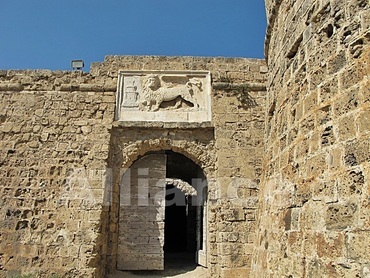Othello’s tower is medieval fortress that is part of defensive walls of Famagusta, built in 12th century. Prior to its construction, there had been a tower and fortifications on the site built by the Prince of Tyre in 1310AD. The Venetians remodeled the current castle in 1492. The Venetians during their works they have also widened the walls by 6 centimeters. Above the main entrance, there is a sculpture of the winged lion of St Mark, the patron saint of Venice, along with an inscription that describes the work of the main architect – Venetian Captain Nicalao Foscareno, who remodeled the castle. Some believe that Leonardo da Vinci visited Cyprus in 1481, and gave advice to Venetians on how better to strengthen the fortress. Instead of demolishing the older Lusignan Period tower and fortifications, they only removed the weaker high walls and replaced them with a more solid wall and placed a circular citadel at the four corners. The citadel contains corridors leading to artillery chambers which in times of war would have allowed soldiers to move quickly from one part of the castle to another. To the north and south of the rectangular central courtyard is series of five ribbed vaulted chambers, constructed between 1300-1310 AD which are believed to have been used by the Lusignans as dormitories and a refectory.
At the entrance to the courtyard old bronze cannons can be seen lying on the ground. The cannons are in excellent condition, considering they were in the possession of the rain, sun and wind for 400 years. There are also some iron cannon balls as well as stone balls that would have been used in a trebuchet.

Inside the citadel there is a large room and kitchen. The windows of the citadel are small which provided safety for the residents. Glass was not used in the windows and pieces of fabric or carpets were hang on them as protection from the rain and wind. Despite this, the tower was a beautiful and comfortable place to live, the walls of which were decorated with sculptures. Not far from the city there is a vast plain, where the nobles hunted. Stunning view of the harbour and surroundings opens from the top level of the tower. Modern ships still use the same entrance to the port, as it was in the golden age of Famagusta in 1300-1400. However, back then, the entrance to the harbour was defended by huge iron chain slanged across the water.
During the British colonial period, the fort was renamed the Othello’s Tower due to connection with Shakespeare's "Othello", the Moor of Venice. The character was identified with the Venetian governor of Cyprus Christopher Moreau, whose name translates as "the Moor." Governor lived in Cyprus from 1506 to 1508, it is known that he returned to his native Venice without his wife. Perhaps she became the model for the tragic figure of Desdemona?



